There comes a time in every proud DIYer’s life when you need a jigsaw. And since you’re already here, I’d say that time is now. When it comes to saws, the jigsaw is kind of like the jack of all trades with a myriad of applications straight off the bat.
Its ability to cut in both curved and straight lines is unique to jigsaws alone – and the fact that it can slice through anything from steel to wood and ceramics only makes it more useful. Jigsaws are the most popular and versatile power tools out there, which explains why there are so many different types to choose from.
Types of Jigsaws
a. Straight Reciprocating Jigsaws
This type is what most people would call the standard or basic jigsaw. As the name suggest, a straight reciprocating jigsaw moves in repeated up and down motions allowing for powerful, precise, butter-like cuts through challenging materials.
b. Orbital Jigsaws
Orbital jigsaws also maintain the basic up, down motion of straight reciprocators. However, they also add a new forward, backwards dimension to make the saw cut in a slightly circular motion. This orbital sawing creates additional power that allows for more aggressive cuts on tough materials while also clearing debris at the same time.
Key Features and Considerations When Buying a Jigsaw
a. Speed Settings
Jigsaws are among the few power tools whose speed is measured in spm – strokes per minute instead of the usual rpm – rotations per minute. The speeds can range from as low as just 500 SPM to as high as 4000 strokes. But what’s more important than the SPM is the ability to control it. The more adjustable speed settings you have, the finer, versatile, and more precise your cuts will be.
b. Material
Most people working with jigsaws are woodworkers, but if you’re a home DIYer looking to get the most from your saw, you’ll appreciate one with the ability to cut through different materials. Some jigsaws work just as well on ceramic and plastics as they do on wood. But if you’re working with metal sheets, you’ll want a saw powerful enough to saw through thick metal sheets.
c. Power Source
When it comes to the power source, there are two main types of jigsaws – corded and cordless. Typically, corded models are more powerful than cordless saws and are best applied for those tough, continuous sawing jobs. Cordless jigsaws are battery operated and offer the most convenience when working off the grid. These are more suitable for lighter, smaller jobs that won’t take too long.
Additional Features
- Bevel cutting – All jigsaws come ready to cut at a 90 degree angle allowing for straight, clean cuts. However, others tilt to create a smaller angle for when you need to make bevel cuts.
- Vibration reduction – Like all power tools, jigsaws have some vibrations that can cause skipping, bouncing or hopping when sawing. Buying a jigsaw with vibration reduction will also save your arms from fatigue.
- Dust blower – Some saws come with a dust blower designed to keep dust and debris from the area in front of the cut.
The Best Jigsaw Reviews
1. Bosch PST 700 E Compact Jigsaw
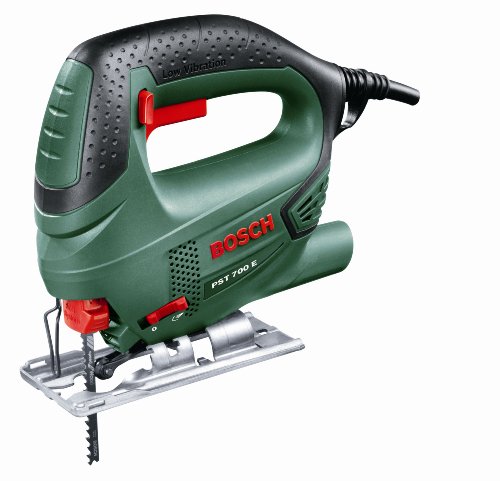
Made by the world renowned tool maker, the Bosch PST 700 E Compact Jigsaw is among the top quality jigsaws in the UK. Looking at the 700 E, it’s clear that Bosch has upgraded their recent line of jigsaws making them lighter, more effective and user friendlier. This particular unit has a range of well thought out features that are more than adequate for both professionals and DIYers.
With a 500w motor, the Bosch PST 700 E Compact Jigsaw can comfortably cut through a thickness of around 70mm deep in wood. This is enough power to slice through tough materials such as 10mm aluminum and 4 mm steel sheets. The manufacturer also included an SDS system that allows users to change the blades safer and faster without the need of other tools. To ensure you have a clean view of your cutting line, the PTS 700E has a blower with an on/off function.
What I like about it:
- Powerful and compact jigsaw – 1.7kg
- Ability to cut through different materials
- SDS system for effortless blade changing
2. Bosch PST 800 PEL Jigsaw
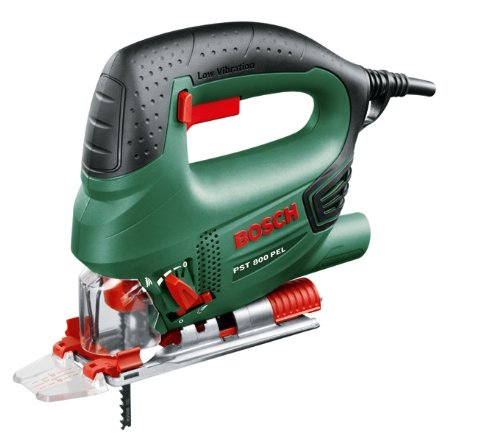
Combining a lightweight design, compact size and exceptional handling, the Bosch PST 800 PEL Jigsaw is a tool fit for a professional on the go. Boasting of robust, modern construction, there is literally no end to how many uses this jigsaw has. While it has all the features and capabilities of the PST 700 E, the 800 E packs in a whole lot more power and additional features.
Bosch installed a powerful 530 W motor to make slicing through tougher materials easier. With wood, the 800 E achieves a cutting depth of 80mm. But here’s where this particular model stands head and shoulders above the rest. The manufacturer included Bosch CutControl so that professionals can enjoy control and precision all while tracking the cut-line safely. What’s more, the tried and tested electronic stroke rate control lets you adjust the spm for material specific work. Like other high quality jigs from Bosch, this one also has an air blast function for clear cutline view at all times as well as vibration reduction.
What I like about it:
- Powerful 530 W motor
- Switchable air blast functions and dust extraction port
- Four stage orbital action for faster sawing
3. BLACK+DECKER KS501-GB Compact Jigsaw
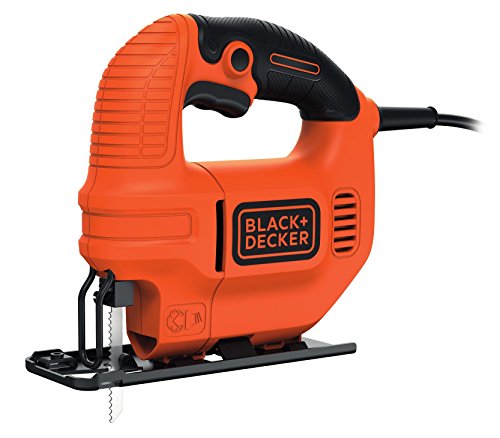
Here’s an interesting model from a brand that needs little introduction in the UK. At first glance, the BLACK+DECKER KS501-GB Compact Jigsaw may seem like a basic model – even the price tag is entry level. But looking at the array of features and capabilities of this unit, that would be seriously underrating it. The KS501 packs a 400 W motor in a light, ergonomically designed frame that is ideal for lighter DIY sawing tasks.
The exact cutting specs are as follows – you can get a cutting depth of up to 65mm of wood, 5 mm steel, and 10 mm aluminum. One of the key features that allows for more precise cuts includes the lock on function. It eliminates the need to constantly hold the trigger switch while operating the saw. There’s also an integrated dust blower that eliminates debris to keep the cutline clear and visible. But what makes the KS501 jigsaw ideal for wood work is the 45 degree angle bevel. It allows for angled and curved cuts in case you want to do some light decoration and wood crafting.
What I like about it:
- Entry level price range
- Light and ergonomic design
- 45 degree bevel cuts for decorative work
4. DeWalt 18V XR Battery Jigsaw
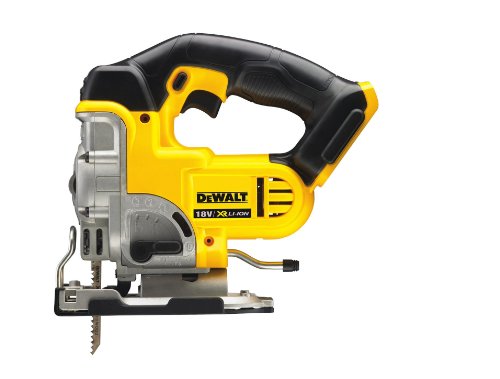
When it comes to cordless models, it doesn’t get more powerful than the DeWalt 18V XR Lithium Ion jigsaw. This bad boy is part and parcel of the intelligent XR battery powered series which has been built for optimum efficiency and faster sawing. The XR may be battery operated, but it boasts of one of the most powerful output on this list. That’s all because of a powerful, high efficient beast of a motor that is fan cooled and capable of swift cutting action of 3000 strokes a minute.
What makes the 18V XR Lithium-Ion jigsaw from DeWalt one of the best in the UK is its ability to combine raw cutting power with comprehensive control. The 3000 spm speed is set and controlled by an intelligent variable speed trigger and a lock switch for enhanced work safety and quicker controlled cuts. For even more control of the aggressiveness or smoothness of cuts, you can set the 3 position pendulum. This model makes use of a patented easy keyless blade system that also takes T-Shank blades if you prefer them.
What I like about it:
- Exceptionally high quality advanced jigsaw
- Super fast cutting action of up to 3000 SPM
- Anti-vibration, ergonomic rubber coated grip
5. Makita 4329/2 Orbital Action Jigsaw
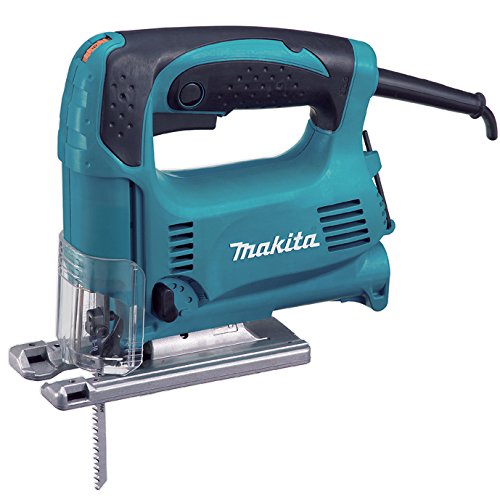
With power tool manufacturing expertise that spans close to 100 years, Makita continues to produce high quality designs that have stood the test of time. The Makita 4329/2 Orbital Action Jigsaw strikes one as a great alternative to high end, popular jigsaw brands. This particular model has a broad range of stroke speeds as well as a powerful 450 W motor. The motor is fitted with an aluminium base plate and a soft start to quickly start your power tool.
Makita made certain to include full variable speed control that can be used to set the saw to a speed of between 500 to 3100 strokes a minute. This allows the jigsaw to have a cutting depth of 65mm in wood and 6mm in steel. At the side are two finger triggers with a lock on button so you don’t have to hold the switch from start to finish. In addition to straight cutting, there are three orbital settings for cutting through varied materials efficiently and a dust port that goes through the body for optimal dust management. Users can cut through the 90 degree angle all the way to a bevelled, 45 degrees left or right.
What I like about it:
- Great alternative to high end brands
- Variable speed control that maxes at 3100s SPM
- Vacuum port for connecting a dust extractor
Frequently Asked Questions
Q: How to use a jigsaw?
Safety first! Always make sure that you have the correct gear before you start cutting with a jigsaw – eye protection is a must, and ear defenders are a good idea too. A dust mask is also an essential piece of safety equipment when using a jigsaw, as the fine particulate can irritate your airways.
- Clamp the piece of material you are going to be cutting in a bench vice so that it doesn’t slide around as you are cutting and affect your straight lines – or worse, cause you injury.
- Jigsaws have a trigger underneath the handle which will start the saw – squeeze this and keep it held down to keep the saw going. Most jigsaws have a lock switch too – push this with your thumb to lock the trigger in place.
- You can adjust the dial to change the speed of your blade – a slower speed means more accurate cuts, or for cutting through metal, while the faster speeds means you can get through wood and laminate easier.
- Mark the line on the material you are about to cut through, so that you can be more accurate. Follow the outside of the line so that you don’t overcut the material.
- Guide the blade through the material, keeping the base plate plate against the material to make a straight line. Don’t push too hard; let the saw guide you.
Q: How to cut a straight line with a jigsaw?
This is the most simple of cuts you can do with a jigsaw. If you are experienced then you can just make an initial mark and follow it to the other side of the wood; if you are less sure of your eye then draw a line across the whole length that you want to cut and just follow this.
Make sure that you cut along the outside of the line you have drawn, so that you don’t accidentally cut off more than you want to. Allow the saw to cut itself to a degree; follow the line but don’t push it too hard as this may make it shoot off track.
Make sure you cut all the way to the end of the line, otherwise you will be left with a jagged corner that may well break and ruin all your careful work.
Q: How to cut a circle in wood with a jigsaw?
For smaller circles, use a narrower blade and for larger ones using a wider blade will be fine. Draw a circle on the material you are looking to cut into – you can do this using a mould, or a compass.
If you don’t have a mould or a compass you can draw a circle on your material with a nail, a piece of string and a pencil – simply place the nail on the centre of your circle, tie the string to one end of the nail and the pencil to the other, then draw the circle by stretching out the string and drawing the circle.
Next, you will need to cut an entry hole to allow the jigsaw blade in – use a large drill bit that is wide enough to fit the jigsaw blade.
Drill the hole inside the circle rather than outside it, so that you don’t affect the circle you are cutting. Secure the wood before you cut the circle, to keep it stable.
Follow the line of the circle you have drawn, and make sure that you stay within the line so that you cut the circle to the size you are looking for.



